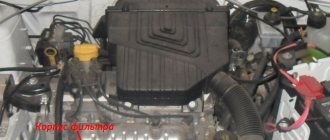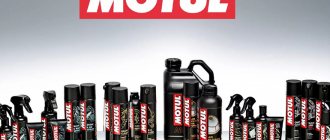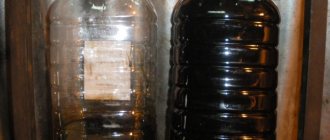Most modern motor oils are universal and all-season. They can be poured into both gasoline and diesel engines in winter and summer. The SAE temperature range is indicated by numbers separated by the letter W, indicating winter.
For example, 15W40. Here the letter refers to the first digit. In this case, the first numbers indicate low temperatures at which the oil will not become very thick. The last figure is related to the summer operation of the car. It shows at what high temperatures the lubricant will not be too liquid. If you ignore these parameters, the engine oil will not be able to perform its functions.
Look at the instructions
This is universal advice for many operations that you carry out on your car. If the car is under warranty, then you cannot violate the instructions, and it is better to have the work performed by an authorized dealer.
Let me remind you that the viscosity of the oil, which directly affects the temperature range of operation, is denoted by two numbers and the letter W according to SAE. An example is the designation 5W-40. The first number characterizes the low-temperature properties of the oil, and the second determines its behavior at engine operating temperatures.
Rating of all-season oils ideal for summer
Based on their composition, mineral, synthetic and semi-synthetic motor oils can be distinguished:
- Minerals are a product of direct oil refining. This natural lubricant has certain disadvantages. On the other hand, it is the safest for old worn-out engines. The most commonly used viscosity here is 15 W-40, 20W-50.
- Semi-synthetics combines a mineral and synthetic base. Suitable for extreme temperatures and high speed.
- Synthetic oils were created in laboratory conditions, so they can boast better performance in protecting the engine. But such compositions contain additives that are aggressive towards rubber seals and gaskets. Therefore, synthetics with a viscosity of 5W-40 are better used for modern power units. The following brands of oil are best suited for summer use.
What region do you live in?
If your place of residence is the southern regions of the country, then it is better to use summer oil - for example 15W-40 or 10W-50. But with the same success, you can use an all-season oil with a “big” second number - 40 or 50. But if you live somewhere beyond the Urals, in areas with a sharply continental climate, then it is advisable to think about dividing the oils into winter and summer.
Filling with high-viscosity oil is a good idea for residents of areas with hot summers.
Filling with high-viscosity oil is a good idea for residents of areas with hot summers.
All-season characteristics
The name itself suggests that this substance can be used in all seasons of the calendar year. All-season lubricants are designated SAE 0W-30 or 0W-40 to SAE 20W-40 and are a symbiosis of summer and winter lubricants. Moreover, the first letter indicates the level of viscosity at negative temperatures, and the second letter characterizes the above-mentioned indicator at positive ambient temperatures.
Good to know: Which motor oil is not counterfeited in Russia, list of the best
Actual motor condition
When deciding whether to use summer oil, you need to evaluate the actual condition of the engine. If the engine reaches its last thousand kilometers before being written off or overhauled, then it is advisable to pour the thickest summer oil into it so that the end of operation does not come suddenly, but as planned.
The brand can be anything. Viscosity and quality are important.
The brand can be anything. Viscosity and quality are important.
What kind of oil should I pour into the engine at 200,000 mileage?
This is the most common option for most regions, and after 100-150 thousand kilometers it is better to switch to 5W40. As soon as the odometer shows 200 thousand km, it is worth filling in 10W40.
Interesting materials:
Is it possible to eat Olivier on day 3? Can you eat olives just like that? Is it possible to eat toothpaste? Is it possible to eat before the bath? Is it possible to eat before a morning run? Can I eat pizza the next day? Can blackened shrimp be eaten? Can you eat a completely black banana? Is it possible to eat Polish mushroom? Is it possible to eat pomelo if you have a stomach ulcer?
What about brands?
I am sure that in the motor oil market there are no outright leaders and absolutely lagging behind. The main thing is that you do not purchase a fake. Therefore, I advise you to buy oil at branded gas stations and large chain auto parts stores. Make sure that the API quality level is no worse than that prescribed by the manufacturer. Let me remind you that the line of oils, as quality increases, looks like this for gasoline engines: SL, SM, SN, SN plus.
Oil change intervals in summer
When producing ROLF motor oils, their characteristics not only meet the requirements of the declared quality classes and manufacturer approvals, but also exceed them with a margin sufficient for long-term operation of the product. However, increasing the replacement period established by the car manufacturer is not recommended.
The fact is that replacement intervals are set by factories so that after their expiration the oil does not “go to zero”, but retains a sufficient level of protective properties, and the viscosity does not exceed the requirements of the standard. The quality of engine oil is one of the main factors affecting engine life. It is impossible to independently determine the timing when the oil will “use up”, if they are not indicated in the service book, without laboratory tests. Therefore, when choosing ROLF products, follow the intervals recommended by the manufacturer.
Expert advice
If the car manufacturer recommended pouring semi-synthetics into the car, you should not pour mineral water into the car. You can greatly reduce the operating life of the engine.
The same goes for synthetics. Synthetic oil is expensive and can negatively affect the condition of the engine.
If you fill your car with the wrong lubricant, this can lead to reduced oil change intervals and damage to engine parts. In addition, you should not pour “cheap stuff” into the internal combustion engine.
The best option is to buy an average-priced oil recommended by your car manufacturer.
Advantage of synthetic oil
Manufacturers of motor oils use 2 codes indicated on the label to indicate the viscosity index.
For example, you can consider the label of a canister of 10W40 oil.
The first part of the code indicates the viscosity of the motor oil at low temperature conditions. The lower the number, the thicker the oil you are pouring. Motor oil intended for cars operated in severe winter conditions is characterized by the fact that the first number is small.
In the 2nd part, high-temperature viscosity is indicated.
Should I mix oils of different viscosities or not?
Surely many inexperienced motorists are wondering whether it is possible to mix semi-synthetic oil with pure synthetics. This question arises especially when it is sharply cold outside, but fresh semi-synthetic oil has already been poured into the engine.
In this case, if you want to save money, the car enthusiast will probably just want to add synthetics that are more resistant to low temperatures. Of course, even adding a small amount of pure synthetics will significantly improve the quality of the original (semi-synthetic) oil filled in early. On the other hand, a compatibility problem arises here, because not every synthetic can be mixed with semi-synthetics. Based on this, we can conclude that before the winter season the best solution would be a complete switch to synthetic oil. To do this, you need to drain the semi-synthetic and flush the engine, replace the oil filter and fill with fresh synthetic oil.
Stages of replacing lubricant VAZ 21214
Changing the engine oil is a regulated maintenance procedure, which is prescribed in the operating instructions. There is nothing complicated about it if you clearly and carefully follow the described action plan.
The replacement operation will be the same for different modifications of the Niva car:
- VAZ 21214
- VAZ 21213
- VAZ 2121
- VAZ 2131
Our most popular engines are injection and carburetor engines, with a volume of 1.7 and 1.6 liters. The replacement process on these engines, as well as other modifications, will be the same.
Draining waste fluid
It is necessary to drain the used engine fluid when the engine is warm. This is due to the fact that heated oil is more liquid. This makes it easier for it to leak out of the thin channels of the lubrication system.
To drain old engine oil, it is advisable to drive the VAZ 21214 (Niva) onto a pit or overpass, since the drainage is done from below. If this is not possible, then the most inconvenient step will be unscrewing the drain plug. Especially if there is protection installed that will need to be removed.
When everything is ready, we proceed to the draining operation:
- Raise the hood, then find the filler neck on the engine and unscrew the cap (Fig. 1).
Fig.1 Oil filler neck
- We unscrew the oil filter, which is located on the right side of the engine, on the spare wheel side. You can try to get to it from under the hood. But if the drain is made from a hole, then it will be more convenient to unscrew it from below (Fig. 2).
Fig.2 Oil filter
- Now we go down under the car and place a waste container in the drainage area. You can use a cut canister or an old bucket.
- We unscrew the drain plug using a 12 hexagon, which is located in the front part of the internal combustion engine (Fig. 3).
Fig.3 Drain plug
To unscrew the filter element, it is advisable to have a special puller. If it is not available, you can try to unscrew the filter using improvised means. In this case, you can use, for example, an old alternator belt, a regular belt, a bicycle chain or a simple screwdriver.
Unscrewing the oil filter using improvised means
Using this method, you can drain the maximum amount of used oil, after which you can proceed to further actions. The main thing is not to forget, everything that we unscrewed must be put back in place.
Flushing the lubrication system
Flushing the engine on a Niva 21214, 21213 should only be carried out in exceptional cases, which include:
- Purchasing a used car when you cannot know about the quality, as well as the regularity of lubricant replacements.
- During operation, the service replacement interval was repeatedly exceeded.
- Engine operation with constant frequent overheating, which contributes to coking and other deposits.
- In cases of switching to another type, for example from synthetics to semi-synthetics.
There are several types of flushes for the Niva 2121 engine:
- Five- or seven-minute, capable of cleaning even the most difficult deposits. They must be used very carefully and strictly follow the instructions printed on the packaging. It is recommended to use them only when absolutely necessary. Since there is a high probability of causing premature wear of the sealing seals. And also clog the oil channels with particles of washed away carbon deposits.
- Special compounds that are added to the oil several hundred kilometers before the expected change. They are more gentle, but there is also a possibility of clogging of the oil channels.
- Flushing oil is the most gentle method of cleaning the engine from the inside. This composition is poured after draining the waste, the engine runs for 15-20 minutes, after which the liquid with deposits is drained. The absence of aggressive additives in the wash composition gently cleans the engine, but is not able to remove heavy contaminants.
- Regular oil that you are going to use when changing. This method is not so popular due to its high price.
Before flushing a VAZ Niva, you should weigh all the pros and cons. And also understand that it will not be possible to completely drain the liquid. Some of it will remain in the channels, which will then mix with the new oil.
Installing a filter, filling in new engine fluid
If the lubrication system of the VAZ 21214, VAZ 21213 (Niva) is sealed and does not require repair work to eliminate leaks, you can proceed to adding fresh oil. In addition to the engine oil itself, sometimes, when worn, it is recommended to change the bolt closing the drain hole. The original has article number 2101-2401046. As well as the original LADA oil filter 2105-1012005-82, from the factory, it is often installed from. If you wish, you can look at analogues on the Internet.
Consumables for maintenance
When everything is ready, let's move on to the bay:
- Replace the drain plug and replace it with a new one if necessary.
- We wipe the seat under the filter.
- We tighten and put in place the new oil filter. Pre-lubricate the rubber sealing ring with fresh oil.
- Pour new oil into the filler neck.
- We check the level on the dipstick; it should be between the MIN and MAX marks.
- We start the engine, let it run for 10-15 seconds, then turn it off.
- After 5 minutes, check the level with a dipstick and top up if necessary.
There are several opinions regarding replacing the oil filter. Many old-school owners advise filling it with new oil before installation. However, nothing is said about this in the official Lada Niva operating instructions. And also in information from global filter manufacturers it is recommended to simply lubricate the o-ring.
The best winter oils
1.Lukoil Lux SL/SF 10W-40 is a Russian-made semi-synthetic oil, made on an all-season basis and suitable for gasoline and diesel power plants. Recommended not only for VAZ and foreign cars, but also suitable for minibuses and LCV cars. This semi-synthetic increases the service life of the internal combustion engine and ensures quick start-up at low temperatures. In addition, this oil does not have a negative effect on the catalytic converter. 2.TNK Magnum Motor Plus 10W-30 is an all-season “mineral water” at an affordable price and with improved characteristics. This modern product is suitable for VAZs and foreign cars with gasoline and diesel engines. TNK oil ensures reliable starting at temperatures down to minus 25 degrees. Moreover, the effectiveness of the oil does not depend on the class of the car - be it cars, trucks, minibuses, etc. Based on reviews, you can be convinced that this oil works well both in winter and in summer until the next scheduled replacement. 3.Shell Helix Ultra ECT C2/C3 0W-30 is one of the best winter oils for diesel cars. Made on a synthetic base with the addition of potent components that improve engine performance and reduce CO2 emissions. With this oil, you can be sure of trouble-free starting of the internal combustion engine in harsh winter conditions. 4.Castrol Turbo Diesel 0W-30 is an expensive synthetic oil for modern turbocharged diesel engines. Contains a wide range of powerful German-made beneficial additives that reduce CO2 levels and increase engine endurance under extreme loads. This liquid has approvals from premium brands such as Mercedes and BMW. In addition, Castrol oil never darkens and is adapted to the harsh Siberian frosts. 5.Ravenol Arctic Low Saps ALS 0W-30 is a specialized oil for winter operation at temperatures down to minus 52 degrees, which makes this lubricant suitable for the most severe climatic conditions. This is due to the high viscosity and high-strength oil film, as well as good pumpability and instant start of the internal combustion engine in the most severe frosts at minus 35 degrees. and below. In addition, Ravenol oil practically does not age and helps reduce fuel consumption. 6.Liqui Moly Synthoil Longtime Plus 0W-30 is one of the best winter oils for operation at temperatures approaching minus 40 degrees. Has all the benefits of premium oils
Replacement instructions
It would be logical to find out how much oil is in the VAZ Niva 21214 engine and how much motor fluid is required to purchase. If we talk about the volume of liquid being filled, then for the Niva engine it is 3.75 liters. The actual volume of oil in the engine is usually less than that indicated in the vehicle's data sheet. This is due to the fact that when draining the waste, some of the oil still remains in the system. It is almost impossible to clean the engine 100% on your own. You should take plenty of oil, but not much. It is better to take a 5 liter canister of high-quality lubricant. This will allow you to fill the full volume into the crankcase, plus periodically add it as the level changes.
Scheduled oil changes in Chevy Niva and VAZ Niva 21214 engines are performed at approximately the same frequency. The procedure itself is standard and includes compliance with some general rules and safety measures.
To work, you will need to collect some materials and tools. This list includes:
- fresh motor oil in the right quantity;
- an empty container where the waste will be drained;
- funnel for filling;
- fuel filter;
- 12mm hex or 17mm wrench;
- puller for the oil filter (you can do without it);
- inspection hole;
- rags;
- lighting;
- overalls (gloves, closed shoes, thick clothing).
If you have everything ready, you can start working. Be sure to follow the instructions step by step, do not rush and do not try to unscrew or tighten anything by applying great force. Otherwise, you risk breaking some parts, which will lead to more expensive repairs. We begin the procedure for changing the engine oil, changing the filter at the same time.
- Place the car on an inspection hole to have easy access to the bottom where the oil pan is located. The engine should be warmed up first so that the oil acquires a more liquid structure and can easily drain from the sump.
- If you warmed up the engine at idle, wait a few minutes so that all the liquid drains down. You can still unscrew the filler plug in the engine compartment. This will allow the oil to come out from below faster.
- Carefully unscrew the drain plug. It comes in different types, so you will need a hexagon or wrench to dismantle it. Before you begin to unscrew the cap, place an empty container under it. Unscrew completely and let the oil drain. This will take about 10 – 15 minutes. Therefore, at the same time, work on the oil filter.
- If the oil comes out very dirty, then a lot of debris, chips and dirt will remain in the system. In this condition, it is recommended to flush the engine. To do this, use special additives, flushing mixtures or fresh oil.
- There are additives that you simply add to the filler neck while the old grease is still there, start the engine and let it run for a few minutes. Then they are jammed and everything is removed from the pan.
- The option with flushing oil or regular fresh engine oil looks different. First, the old fluid is drained, then the drain plug is closed, fresh oil is added, the engine is turned on and it runs at idle speed for 5 - 10 minutes. Now the pan plug is unscrewed again and drained. If the engine is heavily dirty, it is recommended to repeat the procedure 2–3 times. This takes a lot of oil, but it gives the engine new life.
- Only after complete washing is the old filter removed and a new one installed in its place. The filter is unscrewed with a puller, manually or with an improvised tool. The puller is the most convenient, but is not always available to the car owner. Be careful not to damage adjacent pipes and wiring. For safety reasons, it is better to remove the negative terminal from the battery.
- Clean the holes for the drain plug and the filter if there is dirt there. Otherwise, they may get into the fresh motor fluid.
- Before reinstallation, check the plug gasket and replace it if necessary. The filter seal is lubricated with oil, and engine fluid is filled to 50% of the volume of the new filter. Now you can install them in place.
- Make sure that the filter and plug are firmly in place and that there are no leaks through them.
- We move on to the engine compartment, where we use a funnel to pour fresh composition through the filler neck. Fill in about 3.5 liters first, since some of the oil remains in the system. Close the lid and run the engine at idle speed for 2 - 3 minutes.
- Turn off the engine and let the oil drain. Take the dipstick and check the level. A trace of the oil film should remain between o and “Max”. If the level is closer to the minimum value, open the lid again, add a little more lubricant and repeat the procedure.
When you start the car, the oil pressure light will come on. It's not scary, it always happens. The indicator will go out after a few seconds. Over the next few days, monitor how your Niva behaves. Check under the car for traces of fresh oil. Leaks may occur due to a poorly installed filter or drain plug. Tighten the connections and recheck the level.
Owners of the VAZ Niva 21214 car are advised to periodically monitor the oil level, add it as needed and react promptly if the liquid suddenly changes color, becomes cloudy, its consumption increases or the engine overheats. Signs like these indicate more than just a leak. There is a possibility that you chose the wrong oil or there are problems with the engine that cannot be eliminated by simply replacing consumables. You will need to seek qualified help.
Recommendations for choosing oil for the VAZ-2110 car engine
The question of what kind of oil to pour into the VAZ-2110 engine, which is equipped with an 8-valve injector, is asked by many car owners, especially beginners. Synthetic or mineral water? ZIC or Castrol, Mobil or Shell? There is no exact answer, “to each his own.” However, in this article we will make a compelling case about the lubricants that are worth using.
Key points when choosing a lubricant
When choosing oil for the VAZ-2110, you should pay attention to:
Discounts on new cars! Advantageous loan from 9.9% Installment plan 0%
- seasonality (winter, summer or all-season);
- viscosity;
- vehicle make;
- composition of the lubricant (semi-synthetic, mineral or synthetic).
If in the case of “advanced” drivers (with experience), as a rule, no problems arise, they clearly know what they need, then troubles often happen with beginners - they buy the lubricant that the seller advises (often to their advantage ).
The modern market provides various oils, for example: 5W-30, 10W-40, 15W-40 and so on.
Choosing a motor lubricant manufacturer
The market provides quite a wide choice. Based on the results of numerous studies, we provide the “top 3” oils from the best manufacturers that you should pay attention to:
- Motul 8100 X-clean 5W40 4 l. Guarantees complete cleanliness of the motor, as well as its individual elements. It hardens at a temperature not lower than -40 degrees Celsius.
- Liqui Moly Molygen New Generation 5W-40 4 l. An interesting advantage of this material: the possibility of saving fuel up to 4%. Suitable for year-round use. At the same time, it extends the service life of the vehicle by effectively combating deposits. Ensures smooth and precise operation of the motor. The only negative is the price, it is quite high.
- Castrol Edge 5W-40 4 l. This lubricant uses titanium compounds, which have a more than high level of resistance. In addition to performing its main functions, the oil has a beneficial effect on the engine, that is, it contributes to the full disclosure of its full potential. No delays! When you press the gas pedal, you will feel the smooth operation of the engine. Distinctive feature: positive effect on acceleration dynamics. The disadvantages include a change in the sound of the engine.
It is also worth paying attention to lubricants from Lukoil, Mobil, Shell or ZIC. According to statistics, the lubricants of these companies are not consumed and do not cause problems both in the winter and in the summer.










